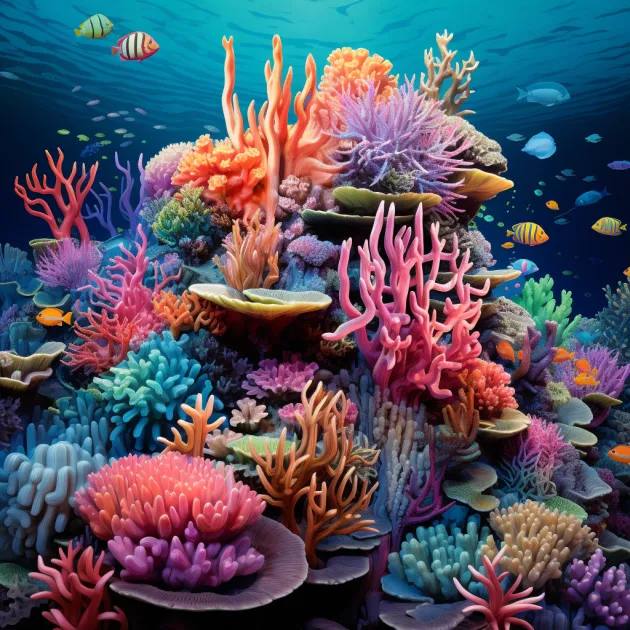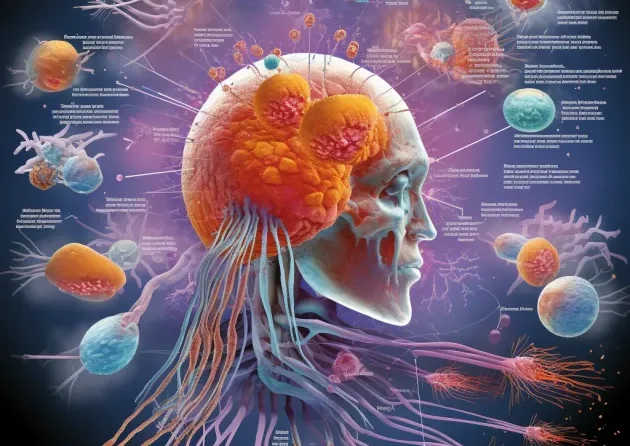
Viruses, as enigmatic entities, have captured the attention of scientists for decades, primarily due to their complex interactions with host organisms. Among the various ways viruses interact with their hosts, the integration of endogenous viral elements (EVEs) into host genomes has emerged as a particularly intriguing aspect. EVEs are remnants of ancient viral infections that have become integrated into the DNA of their host organisms and have been passed down through generations. The study of these EVEs offers unique opportunities to uncover the evolutionary history of viruses and their hosts.
Recently, a group of researchers delved into the investigation of EVEs derived from dinornavirus (dinoRNAV) within dinoflagellates and cnidarians, with a specific focus on coral holobionts. Dinoflagellates are a diverse group of marine microorganisms that play a critical role as primary symbionts in coral reef ecosystems. The association between dinoflagellates and corals is a mutualistic symbiosis, where dinoflagellates, commonly known as zooxanthellae, provide essential nutrients to the coral host through photosynthesis, while the coral provides a protective environment and essential compounds for the dinoflagellates’ growth.
During the course of this mutualistic relationship, researchers have discovered the presence of dinoRNAVs within dinoflagellates and cnidarians, but their evolutionary significance and the mechanisms by which they become integrated into the host genomes have remained largely unknown. Understanding the dynamics of these EVEs and their potential functions could shed light on the co-evolution of viruses and their host organisms and offer valuable insights into the intricate relationships that shape coral reef ecosystems.
To unravel the mysteries surrounding dinoRNAV EVEs, the researchers employed a comprehensive approach that combined cutting-edge techniques such as metagenomic analysis, genome assemblies, and comparative genomics. By harnessing the power of these advanced tools, the scientists aimed to decipher the genetic architecture of the viral elements present within the genomes of dinoflagellates and cnidarians, offering an unprecedented glimpse into the evolutionary history and functional implications of these viral remnants.
In this study, we present the findings of this research endeavor, which could have far-reaching implications for our understanding of viral-host interactions and the intricate web of connections that sustain the delicate balance of coral reef ecosystems. By gaining insight into the integration and potential roles of dinoRNAV EVEs, we hope to unravel the cryptic past of viruses and their role in shaping the diversity and resilience of marine ecosystems. Ultimately, this research contributes to the broader understanding of the co-evolutionary dynamics between viruses and their host organisms, shedding light on the fascinating world of endogenous viral elements and their impact on the natural world.
Methods and Findings of dinoRNAV:
In the pursuit of understanding the presence and distribution of dinoRNAV EVEs, the researchers made use of publicly available datasets and genome assemblies, ensuring robust and reliable data for their analysis. Metagenomic data obtained from coral holobionts provided valuable insights into the viral elements present in the complex microbial communities associated with corals. Additionally, genome assemblies from dinoflagellates and aposymbiotic cnidarians allowed for a detailed investigation of the integration of dinoRNAV EVEs within the genomes of these host organisms.
To identify putative dinoRNAV EVEs, the researchers employed alignment techniques on scaffold-scale genome assemblies. This meticulous approach allowed them to pinpoint the locations of these viral remnants and provided a foundation for further analysis. The distribution of dinoRNAV EVEs across different dinoflagellate genera and aposymbiotic cnidarians was explored, revealing intriguing patterns and variations in their prevalence among different host species. Such variations may offer clues about the co-evolutionary dynamics between the viruses and their hosts.
To gain insights into the mechanisms of integration of dinoRNAV EVEs, the genomic neighborhoods of these viral elements were thoroughly examined. This investigation allowed the researchers to identify the genes and genetic elements located proximal to the integration sites. Notably, the presence of host-provisioned retroelements like LINEs in these neighborhoods suggested potential mechanisms of integration, such as retrotransposition facilitated by the host’s own machinery. Moreover, the identification of dinoflagellate spliced leaders (dinoSLs) in close proximity to EVEs hinted at a possible role of these RNA structures in the integration process.
To shed light on the evolutionary history of dinoRNAV EVEs, phylogenetic analysis was conducted. By comparing these viral elements with known exogenous dinoRNAVs and related +ssRNA viruses, the researchers could infer their evolutionary relationships and assess the conservation of critical motifs. Understanding the evolutionary patterns of these EVEs can provide valuable information about their origins and potential interactions with other viruses.
The study also ventured into exploring the expression and functional potential of dinoRNAV EVEs. By deciphering how these viral remnants are expressed and regulated within their host genomes, the researchers could gain insights into their potential roles in triggering antiviral mechanisms. Such findings may shed light on the intricate interplay between viruses and their hosts, providing clues about the strategies employed by dinoflagellates and cnidarians to defend against viral infections.
Discussion and Implications of the dinoRNAV:
The comprehensive investigation of dinoRNAV EVEs in dinoflagellates and cnidarians has opened up new avenues of scientific inquiry and raised exciting questions about the evolution and interactions between viruses and their hosts. The wide distribution of dinoRNAV EVEs, particularly in the important coral symbiont genus Symbiodinium, implies recurrent and ancient integration events. This suggests that the integration of viral elements into host genomes has played a significant role in shaping the genetic landscape of these organisms over evolutionary time.
The identification of host-provisioned retroelements and the association of dinoSLs with EVEs offer compelling evidence for the proposed mechanism of retrotransposition in dinoRNAV integration. This discovery provides crucial insights into the intricate processes by which these viral remnants have become integrated into the host genomes, hinting at a host-mediated defense mechanism against viral infections.
Phylogenetic analysis has revealed the striking homology of dinoRNAV EVEs with extant dinoRNAVs, suggesting that these elements have been a longstanding presence in dinoflagellates. The chronic infection strategy adopted by dinoRNAVs within their dinoflagellate hosts indicates a long and dynamic co-evolutionary history between viruses and these single-celled organisms. By exploring the evolutionary relationships of these viral elements, we gain glimpses into the ever-evolving arms race between viruses and their host genomes.
While the exact functions and expression patterns of dinoRNAV EVEs remain to be fully elucidated, in silico analyses have pointed to their potential involvement in host immunity and antiviral defense mechanisms. This implies that dinoRNAV EVEs may have played a role in equipping dinoflagellates and cnidarians with the means to fend off viral infections and maintain their health and resilience in the face of environmental challenges.
The ecological and economic implications of understanding dinoRNAV EVEs are substantial, particularly in the context of coral reefs. Coral reefs are among the most diverse and valuable ecosystems on Earth, supporting a vast array of marine life and providing crucial services to human communities. However, they are currently facing unprecedented threats from climate change, pollution, and disease outbreaks, including viral infections. By comprehending the integration and functional implications of dinoRNAV EVEs, we can gain valuable insights into the potential impacts of viral infections on coral reefs and their symbiotic relationships.
Moreover, the study of EVEs in other microbial systems holds the promise of unveiling a broader understanding of the co-evolutionary dynamics between viruses and their hosts across the tree of life. EVEs serve as markers of viral ancestry, providing us with a unique window into the ancient interactions between viruses and their host organisms. This knowledge can have far-reaching implications, from advancing our understanding of fundamental evolutionary processes to informing strategies for combating viral diseases.
Conclusion:
In conclusion, the integration of dinoRNAV EVEs within dinoflagellates and cnidarians presents a captivating aspect of virus-host interactions in coral holobionts. The comprehensive analysis of metagenomic data and genome assemblies in this study has offered valuable insights into the mechanisms and implications of dinoRNAV integration, shedding light on their evolutionary history and potential functional roles.
However, the journey does not end here. Further research is essential to fully understand the specific functions and expression patterns of dinoRNAV EVEs. Unraveling the functional significance of these viral remnants could provide critical knowledge about their impact on the health and resilience of coral reef ecosystems. Moreover, exploring the broader significance of EVEs in other microbial systems and their role in shaping host genomes could unlock new avenues for studying viral evolution and the complex dynamics between viruses and their hosts.
As we continue to delve into the mysteries surrounding dinoRNAV EVEs, this study serves as a stepping stone, offering a solid foundation for future investigations into the virology and ecology of coral reefs. By comprehending the intricacies of virus-host interactions within coral holobionts, we can develop targeted approaches to conserve and protect these vital ecosystems that are increasingly threatened by various environmental stressors.
The exploration of dinoRNAV EVEs adds to our broader understanding of the co-evolutionary dynamics between viruses and their hosts. This knowledge not only enriches our understanding of the natural world but also provides potential applications in biotechnology, medicine, and conservation efforts. With each piece of the puzzle we uncover, we come closer to appreciating the remarkable interplay between viruses and their host organisms, a phenomenon that has shaped life on Earth for millions of years. Embracing the complexity of these interactions will undoubtedly yield fruitful discoveries, driving us towards a deeper appreciation of the wonders of nature and the delicate balance that sustains our planet’s ecosystems.
If you need more information on this article click on the following link. This link will provide more extensive information and elaborate on the topic.
Genomic.News is your ultimate source for curated news, articles, and updates on the fascinating world of genomics. Our platform brings together the latest scientific breakthroughs, research advancements, and industry developments in one centralized hub. Stay informed about the cutting-edge discoveries, transformative technologies, and ethical considerations driving the field of genomics. Explore the intersection of genetics and healthcare, agriculture, biotechnology, and beyond.





